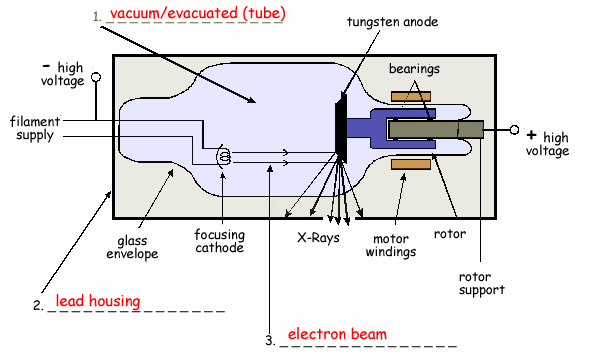'A' Level Medical Option Questions - X-Rays
Q2.

(a) The diagram shows a rotating-anode X-ray tube. Complete the labelling of the three numbered arrows in the diagram.
See diagram 


(3 marks)
(b) Explain why the anode
(i) is rotated,
The anode is rotated so that the heat produced is spread over a greater volume/area/section  This allows more energetic X-rays to be produced [or allows X-rays to be generated for longer]
This allows more energetic X-rays to be produced [or allows X-rays to be generated for longer]  without risk of melting the anode.
without risk of melting the anode.
(ii) has a bevelled edge.
The bevelled edge gives larger target area for the electrons
but a smaller source area from which the X-rays are produced.  This gives a sharper image beam of X-rays and produces a sharper image.
This gives a sharper image beam of X-rays and produces a sharper image.
(3 marks)
(c) Define for a material,
(i) the linear attenuation coefficient, 
The linear attenuation coefficient,  is the fraction of X-rays removed per unit thickness of the material.
is the fraction of X-rays removed per unit thickness of the material. 
(ii) the half-value thickness.
The thickness of the material which will reduce the intensity to half its original level for a specified energy of the X-rays 
(2 marks)
(d) A monochromatic X-ray beam of intensity 6.0 W m–2 is incident on an aluminium sheet of thickness 2.0 mm. For these X-rays, the half-value thickness of aluminium is 3.2 mm. Calculate the intensity of the transmitted beam.

= ln2/3.2
= 0.217 mm-1 
I = Io e- x
x
I = 6.0 x e-0.217x 2 
intensity = 3.9 W m-2 
(3 marks)
(Total 11 marks)


